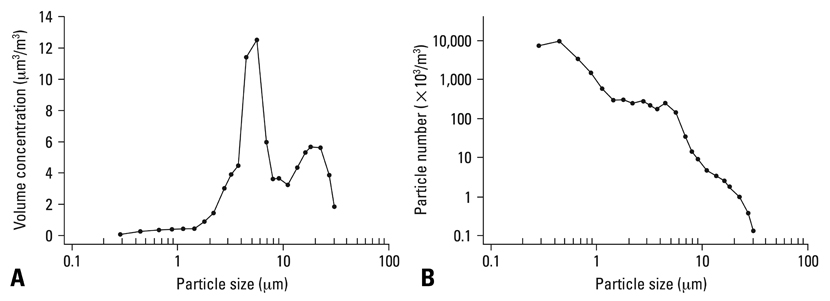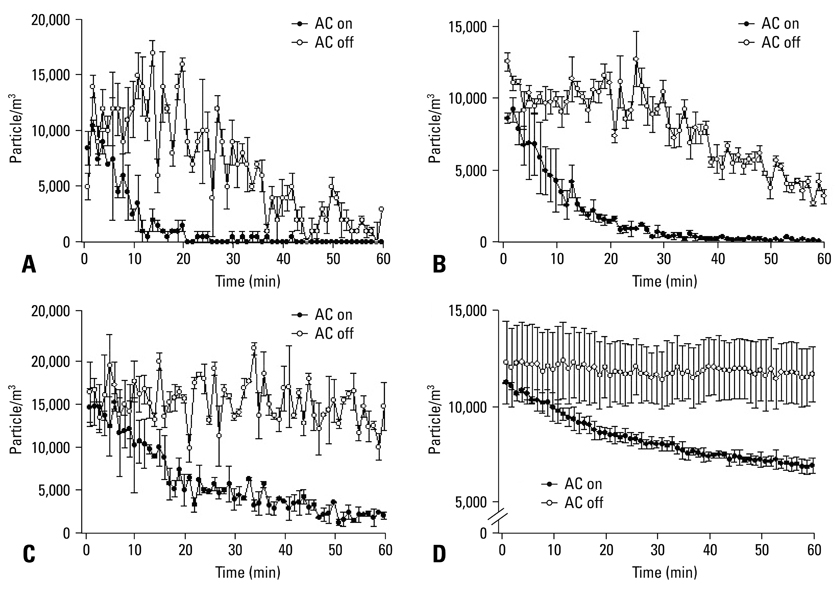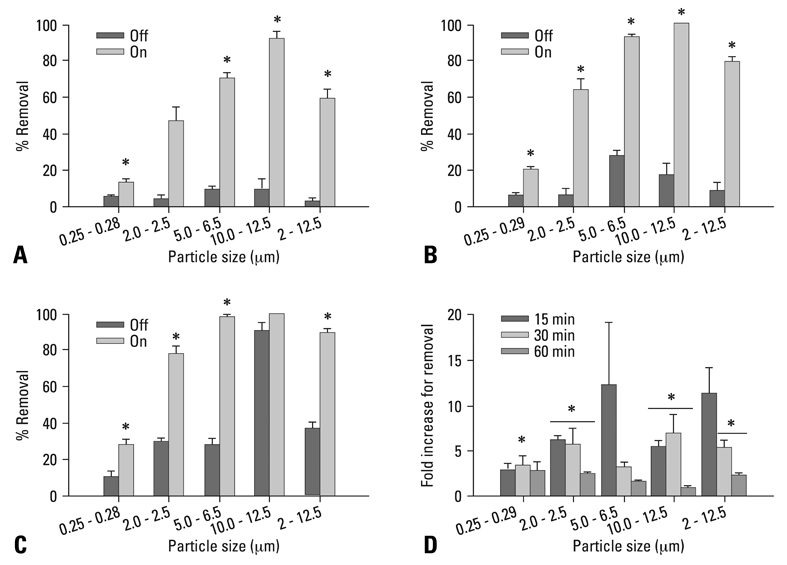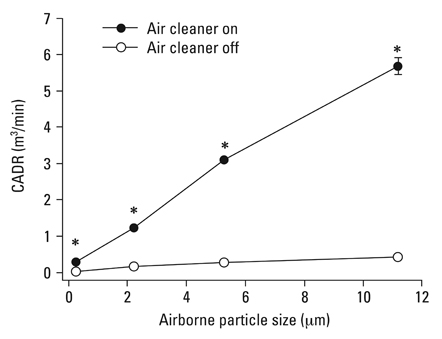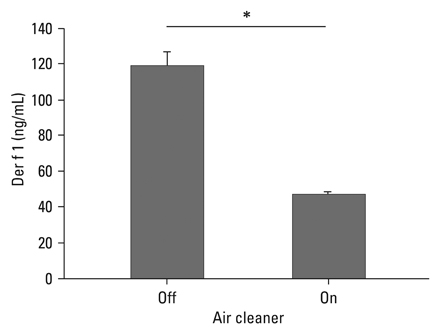Yonsei Med J.
2010 Nov;51(6):918-923. 10.3349/ymj.2010.51.6.918.
Effect of an Air Cleaner with Electrostatic Filter on the Removal of Airborne House Dust Mite Allergens
- Affiliations
-
- 1Division of Allergy and Immunology, Institute of Allergy, Department of Internal Medicine, Yonsei University College of Medicine, Seoul, Korea. parkjw@yuhs.ac
- 2Aerosol Laboratory, Environmental Machinery Research Division, Korea Institute of Machinery and Materials, Daejeon, Korea.
- 3Digital Appliance Company Research Laboratory, LG Electronics, Changwon, Korea.
- KMID: 1779640
- DOI: http://doi.org/10.3349/ymj.2010.51.6.918
Abstract
- PURPOSE
The effects of air cleaners on the removal of airborne indoor allergens, especially house dust mites (HDM), are still controversial. The objective of this study is to evaluate the effect of an air cleaner with an electrostatic filter on the removal of airborne mite allergens.
MATERIALS AND METHODS
A dried HDM culture medium that contained mite body particles and excretions was dispersed in a chamber equipped with an electrostatic air cleaner. The number of airborne particles was recorded continuously by a dust spectrometer for 60 minutes. Airborne particles in the chamber were collected on a sampling filter at a flow rate of 10 L/min and the Der f 1 concentration in the filter extracts was measured by two-site ELISA.
RESULTS
The air cleaner efficiently removed airborne HDM particles. The air cleaner removed airborne HDM particles (size 2-12.5 microm) 11.4 +/- 2.9 fold (cleaner operating for 15 minutes), 5.4 +/- 0.7 fold (cleaner operating for 30 minutes), and 2.4 +/- 0.2 fold (cleaner operating for 60 minutes) more than the removal of HDM particles by natural settle down. Removal kinetics differed according to the particle size of the airborne particles. The air cleaner decreased the concentration of Der f 1 in the extraction of airborne particles collected on the air sampling filter by 60.3%.
CONCLUSION
The electrostatic air cleaner can remove airborne HDM allergens and may be useful as a supplementary environmental control tool for HDM sensitized respiratory allergic patients.
MeSH Terms
Figure
Cited by 1 articles
-
Effect of air purifier on indoor air quality and atopic dermatitis
Hyun Chul Park, Young Hoon Kim, Jeong Eun Kim, Joo Yeon Ko, Sun Ju Nam Goung, Cheol Min Lee, Yoon Shin Kim, Young Suck Ro
Allergy Asthma Respir Dis. 2013;1(3):248-256. doi: 10.4168/aard.2013.1.3.248.
Reference
-
1. Sporik R, Holgate ST, Platts-Mills TA, Cogswell JJ. Exposure to house-dust mite allergen (Der p I) and the development of asthma in childhood. A prospective study. N Engl J Med. 1990. 323:502–507.
Article2. Wahn U, Lau S, Bergmann R, Kulig M, Forster J, Bergmann K, et al. Indoor allergen exposure is a risk factor for sensitization during the first three years of life. J Allergy Clin Immunol. 1997. 99:763–769.
Article3. Eggleston PA. Improving indoor environments: reducing allergen exposures. J Allergy Clin Immunol. 2005. 116:122–126.
Article4. Wood RA, Johnson EF, Van Natta ML, Chen PH, Eggleston PA. A placebo-controlled trial of a HEPA air cleaner in the treatment of cat allergy. Am J Respir Crit Care Med. 1998. 158:115–120.
Article5. Green R, Simpson A, Custovic A, Faragher B, Chapman M, Woodcock A. The effect of air filtration on airborne dog allergen. Allergy. 1999. 54:484–488.
Article6. Reisman RE, Mauriello PM, Davis GB, Georgitis JW, DeMasi JM. A double-blind study of the effectiveness of a high-efficiency particulate air (HEPA) filter in the treatment of patients with perennial allergic rhinitis and asthma. J Allergy Clin Immunol. 1990. 85:1050–1057.
Article7. Antonicelli L, Bilò MB, Pucci S, Schou C, Bonifazi F. Efficacy of an air-cleaning device equipped with a high efficiency particulate air filter in house dust mite respiratory allergy. Allergy. 1991. 46:594–600.8. Reisman RE. Do air cleaners make a difference in treating allergic disease in homes? Ann Allergy Asthma Immunol. 2001. 87:41–43.
Article9. Sheikh A, Hurwitz B, Shehata Y. House dust mite avoidance measures for perennial allergic rhinitis. Cochrane Database Syst Rev. 2007. 24:CD001563.
Article10. Sulser C, Schulz G, Wagner P, Sommerfeld C, Keil T, Reich A, et al. Can the use of HEPA cleaners in homes of asthmatic children and adolescents sensitized to cat and dog allergens decrease bronchial hyperresponsiveness and allergen contents in solid dust. Int Arch Allergy Immunol. 2009. 148:23–30.
Article11. Waring MS, Siegel JA, Corsi RL. Ultrafine particle removal and generation by portable air cleaners. Atmos Environ. 2008. 42:5003–5014.
Article12. Association of Home Appliance Manufacturers (AHAM). ANSI/AHAM AC-1-2006; Revision of ANSI/AHAM AC-1-2002 and AHAM AC-1-2005. AHAM method for measuring performance of portable household electric room air cleaners. 2006. Washington DC: 16–19.13. Hinds WC. Aerosol technology: properties, behaviors, and measurement of airborne particles. 1998. New York: Wiley-Interscience Publication.14. Tovey ER, Chapman MD, Wells CW, Platts-Mills TA. The distribution of dust mite allergen in the houses of patients with asthma. Am Rev Respir Dis. 1981. 124:630–635.15. de Blay F, Heymann PW, Chapman MD, Platts-Mills TA. Air borne dust mite allergens: comparison of group II allergens with group I mite allergen and cat-allergen Fel d 1. J Allergy Clin Immunol. 1991. 88:919–926.16. Platts-Mills TAE, Heymann PW, Longbottom JL, Wilkins SR. Airborne allergens associated with asthma: particle sizes carrying dust mite and rat allergens measured with a cascade impactor. J Allergy Clin Immunol. 1986. 77:850–857.
Article17. Tovey ER, Chapman MD, Platts-Mills TA. Mite faeces are a major source of house dust allergens. Nature. 1981. 289:592–593.
Article18. Vaughan JW, McLaughlin TE, Perzanowski MS, Platts-Mills TA. Evaluation of materials used for bedding encasement: effect of pore size in blocking cat and dust mite allergen. J Allergy Clin Immunol. 1999. 103:227–231.19. Svartengren M, Falk R, Linnman L, Philipson K, Cammer P. Deposition of large particles in human lung. Exp Lung Res. 1987. 12:75–88.20. Custovic A, Woodcock H, Craven M, Hassall R, Hadley E, Simpson A, et al. Dust mite allergens are carried on not only large particles. Pediatr Allergy Immunol. 1999. 10:258–260.
Article21. Ferguson P, Brodie DH. Environmental and bronchoalveolar lavage Dermatophagoides pteronyssinus antigen levels in atopic asthmatics. Am J Respir Crit Care Med. 1995. 151:71–74.
Article22. De Lucca S, Sporik R, O'Meara TJ, Tovey ER. Mite allergen (Der p 1) is not only carried on mite feces. J Allergy Clin Immunol. 1999. 103:174–175.
Article23. Fox RW. Air cleaners: a review. J Allergy Clin Immunol. 1994. 94:413–416.
Article24. Shaughnessy RJ, Sextro RG. What is an effective portable air cleaning device? A review. J Occup Environ Hyg. 2006. 3:169–181.
Article
- Full Text Links
- Actions
-
Cited
- CITED
-
- Close
- Share
- Similar articles
-
- Efficacy of an air cleaning device equipped with an electrostatic precipitator and photocatalytic plasma filter in respiratory allergic patients
- Indoor Allergen Avoidance and Asthma
- Distribution of House Dust Mites in the Bedroom of Patients with Allergic Rhinitis in Pusan Area
- Repellent effect of Mate tea and Jasmine tea against house dust mites (Dermatophagoides farinae and D. pteronyssinus)
- Food and house dust mite allergens in children with atopic dermatitis

